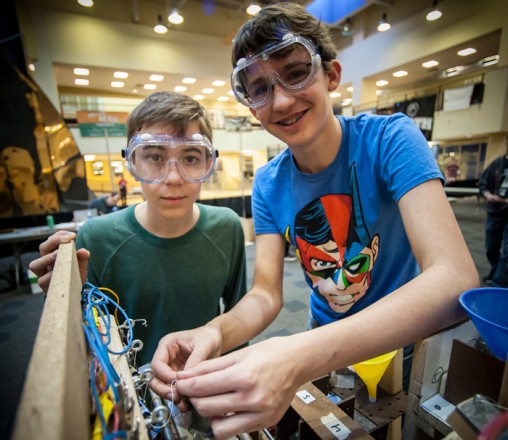
The Science Olympiad Invitational Tournament attracted 1,500 students from 11 states to Wright State to compete in complex hands-on challenges and lab events.
Students launched bottle rockets in the sky, tried not to break uncooked eggs traveling on small handmade vehicles and used rubber bands to fly balsa-wood airplanes at another successful Science Olympiad Invitational Tournament at Wright State University.
The tournament was held in 10 campus buildings and one softball field on Feb. 7. It attracted about 1,500 students and an estimated 400 coaches and family members to Wright State.
This year’s competition included 92 teams from 11 states, including Ohio, Georgia, Indiana, Michigan, South Carolina, Texas and Wisconsin.
Liberal Arts Science Academy from Austin, Texas, won the high school division and Solon Middle School near Cleveland won the middle school division.
Science Olympiad tests middle and high school students’ ability to solve physics, engineering, math, biology and anatomy problems in complex hands-on activities and lab events.
Wright State previously hosted the Science Olympiad National Tournament in 2013 and invitational tournaments in 2011, 2012 and 2014. The university will host its second Science Olympiad National Tournament in May 2017.
Science Olympiad is a national nonprofit organization whose mission is to improve the quality of science education, increase interest in science, attract more students to science careers, foster teamwork, emphasize the problem-solving aspects of science and develop a technologically literate workforce.
- Many Wright State students volunteered at the Science Olympiad Invitational.
- Students set up their entry in “Wheeled Vehicle.”
- “Bottle Rocket” competitors launched rockets made of empty two-liter plastic bottles.
- “Mission Possible” challenged students to create Rube Goldberg devices to complete simple tasks.
- Students receive instructions at “Can’t Judge a Powder” in Fawcett Hall.
- Students set up their egg-carrying vehicle in “Scrambler.”
- In “Bungee Drop” students drop a mass attached to an elastic cord as close to the ground as possible.
- Two “Mission Possible” competitors launched a small ball in the air.









 Wright State Police Department delivers major donation to Raider Food Pantry
Wright State Police Department delivers major donation to Raider Food Pantry  Wright State engineering and computer science students earn prestigious federal SMART Scholarships
Wright State engineering and computer science students earn prestigious federal SMART Scholarships  Wright State Police Chief Kurt Holden selected for prestigious FBI National Academy program
Wright State Police Chief Kurt Holden selected for prestigious FBI National Academy program  Wright State’s Raj Soin College of Business ranked among the best for entrepreneurs by Princeton Review
Wright State’s Raj Soin College of Business ranked among the best for entrepreneurs by Princeton Review  Wright State’s annual Raidersgiving draws hundreds
Wright State’s annual Raidersgiving draws hundreds 